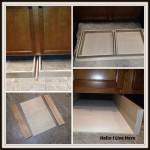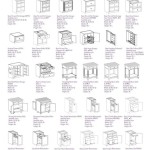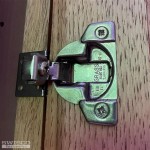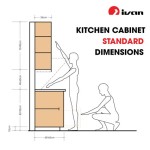Add Crown Moulding to Kitchen Cabinets: A Comprehensive Guide
Crown moulding, traditionally used to bridge the gap between walls and ceilings, can significantly elevate the aesthetic appeal of kitchen cabinets. This decorative trim adds a touch of elegance, sophistication, and a finished look, transforming ordinary cabinets into custom-looking installations. Installing crown moulding is a manageable project for a DIY enthusiast with basic woodworking skills and the right tools. This article provides a detailed guide on how to add crown moulding to kitchen cabinets, covering everything from planning and preparation to installation and finishing.
Planning and Preparation: The Foundation for Success
Before embarking on the physical installation, meticulous planning is crucial. This stage involves assessing the existing cabinet structure, selecting the appropriate moulding style and size, and accurately measuring the cabinet dimensions.
Cabinet Assessment: Begin by carefully examining the cabinets. Identify any structural imperfections, such as uneven surfaces or gaps between the cabinet tops and the ceiling. These imperfections must be addressed before installing the crown moulding. Leveling the cabinet tops might be necessary to ensure a seamless and professional-looking installation. If there are any significant gaps, consider using wood shims or filler strips to create a flush surface for the moulding to sit against.
Moulding Selection: Choosing the right type and size of crown moulding is essential for achieving the desired aesthetic. Consider the overall style of the kitchen and the existing cabinet design. Traditional kitchens often benefit from ornate, detailed moulding, while modern kitchens typically look better with simpler, cleaner lines. The size of the moulding should be proportionate to the size of the cabinets and the overall room dimensions. Too large a moulding can overwhelm the space, while too small a moulding may appear insignificant. Common materials for crown moulding include wood, medium-density fiberboard (MDF), and polyurethane. Wood offers a classic look and can be stained or painted. MDF is a cost-effective option that is easy to work with and takes paint well. Polyurethane is moisture-resistant, making it suitable for kitchens with high humidity levels.
Accurate Measurements: Precise measurements are paramount for a successful installation. Use a high-quality measuring tape to determine the length of each cabinet run. Measure the front of the cabinets and the sides separately, as these lengths may differ. Always double-check your measurements to avoid errors. Create a detailed diagram of the cabinet layout, noting the exact dimensions of each section. This diagram will serve as a reference during the cutting and installation process. When calculating the total length of moulding required, add extra material (approximately 10-15%) to account for mistakes, mitre cuts, and potential waste.
Tool and Material Acquisition: Ensure you have all the necessary tools and materials readily available before starting the project. Essential tools include a measuring tape, a combination square, a pencil, a miter saw (preferably with a digital angle finder), a nail gun or hammer and nails, a stud finder, a level, wood glue, sandpaper, wood filler, paint or stain, and safety glasses. Materials will include the crown moulding itself, wood blocking (for creating a solid base for the moulding), construction adhesive, and painter's tape.
Installation Process: A Step-by-Step Guide
The installation phase requires patience, precision, and attention to detail. Following a systematic approach will help ensure a professional and aesthetically pleasing result.
Preparing the Cabinet Tops: Crown moulding typically requires a solid backing to be properly secured. If the cabinets don't have a sufficient lip or overhang to attach the moulding directly, install wood blocking along the top edges of the cabinets. These blocks will provide a solid surface for nailing or screwing the moulding into place. Use construction adhesive and screws to attach the blocking securely to the cabinet tops. Ensure that the blocking is flush with the front and sides of the cabinets and that it is level. This step is crucial for ensuring that the crown moulding is installed straight and evenly.
Cutting the Moulding: Cutting crown moulding accurately is one of the most challenging aspects of the installation process. Crown moulding is typically installed with mitre cuts at the corners, which require precise angles. The best tool for cutting crown moulding is a miter saw. A miter saw allows you to make accurate angled cuts with ease. There are several techniques for cutting crown moulding, including the "nested" method and the "flat" method. The nested method involves placing the moulding in the miter saw with the bottom edge against the fence and the top edge against the table. The flat method involves laying the moulding flat on the saw table. Regardless of the method you choose, it is important to set the correct angles for the mitre cuts. Outside corners typically require 45-degree mitre cuts, while inside corners require complementary angles. Use a protractor or angle finder to accurately determine the correct angles. Practice cutting on scrap pieces of moulding before cutting the actual pieces to ensure that your cuts are accurate.
Attaching the Moulding: Once the moulding is cut to the correct lengths and angles, it is time to attach it to the cabinets. Apply a bead of construction adhesive to the back of the moulding where it will contact the cabinet tops and wood blocking. Position the moulding carefully and press it firmly against the cabinet tops. Use a nail gun or hammer and nails to secure the moulding in place. Drive nails through the moulding into the wood blocking. Space the nails approximately 6-8 inches apart. For a stronger bond, consider using screws in addition to nails. Countersink the nails or screws slightly and fill the holes with wood filler. Use clamps to hold the moulding in place while the adhesive dries. Check the alignment of the moulding frequently to ensure that it remains straight and level during the installation process. Painter's tape can be used to temporarily hold the moulding in place while the adhesive sets.
Dealing with Corners: Corners are often the trickiest part of installing crown moulding. Inside corners can be particularly challenging, as they often require coping. Coping involves cutting the end of one piece of moulding to match the profile of the adjacent piece. This creates a tight, seamless joint that is less prone to gaps than a simple mitre cut. Use a coping saw or a jigsaw to carefully cut away the back of the moulding, following the profile of the front edge. Test the fit of the coped joint frequently and make adjustments as needed. Outside corners are typically mitred at a 45-degree angle. Ensure that the mitre cuts are precise and that the pieces fit together snugly. Use wood glue to reinforce the joints and clamp the pieces together until the glue dries.
Finishing Touches: Achieving a Professional Look
After the crown moulding is installed, the final step is to finish it to match the existing cabinets and create a cohesive look.
Filling Gaps and Imperfections: Even with careful installation, there may be small gaps or imperfections in the joints. Use wood filler to fill these gaps and create a smooth, seamless surface. Apply the wood filler sparingly and allow it to dry completely. Sand the filled areas smooth with fine-grit sandpaper. Remove any dust or debris before proceeding to the next step. For larger gaps, consider using caulk instead of wood filler. Caulk is more flexible than wood filler and is less likely to crack over time.
Sanding and Priming: Before painting or staining, it is important to sand the crown moulding smooth. Use fine-grit sandpaper to remove any imperfections and create a smooth, even surface. Remove any dust or debris with a tack cloth or a vacuum cleaner. Apply a coat of primer to the crown moulding. Primer helps to seal the wood and provides a better surface for the paint or stain to adhere to. Choose a primer that is compatible with the type of paint or stain you will be using. Allow the primer to dry completely before proceeding to the next step.
Painting or Staining: Choose a paint or stain that matches the existing cabinets or complements the overall kitchen décor. Apply the paint or stain in thin, even coats, using a high-quality brush or sprayer. Allow each coat to dry completely before applying the next coat. For best results, apply two or three coats of paint or stain. If staining, apply a sealant to protect the wood and enhance the finish. Consider using a clear coat varnish or polyurethane for added durability. Pay attention to the direction of the wood grain when applying the paint or stain. Brush or spray in the direction of the grain to avoid streaks or unevenness. Remove any drips or runs immediately with a clean cloth.
Caulking: After painting or staining, apply a bead of caulk along the top edge of the crown moulding where it meets the ceiling. This will help to seal any gaps and create a clean, finished look. Choose a caulk that is paintable and matches the color of the crown moulding. Apply the caulk in a thin, even bead and smooth it out with a wet finger or a caulking tool. Wipe away any excess caulk with a damp cloth. Allow the caulk to dry completely before touching or painting over it.
By following these steps, homeowners can successfully add crown moulding to their kitchen cabinets, enhancing the aesthetic appeal and value of their kitchen. The key to a professional-looking result lies in careful planning, precise execution, and attention to detail.

Adding Crown Molding To Kitchen Cabinets Young House Love

Diy Kitchen Cabinet Upgrade With Paint And Crown Molding

How To Add Crown Molding Kitchen Cabinets Abby Organizes

How To Add Crown Molding Kitchen Cabinets Abby Organizes

Adding Height To The Kitchen Cabinets Tempting Thyme

Adding Crown Moulding To Wall Kitchen Cabinets Momplex Vanilla Ana White

Diy Kitchen Cabinet Upgrade With Paint And Crown Molding

Crown Moulding The Recently Rediscovered Kitchen Solution

Adding Height To The Kitchen Cabinets Tempting Thyme

How To Install Crown Molding On Kitchen Cabinets Sawdust Girl
Related Posts








